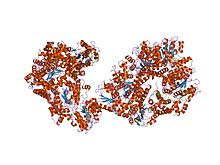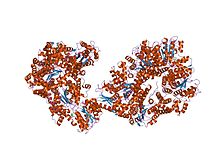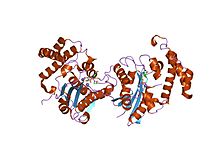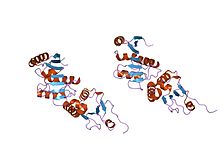- DNA polymerase III holoenzyme
-
- Pol III can also refer to HNoMS Pol III, a Norwegian guard vessel from WWII
DNA polymerase III holoenzyme is the primary enzyme complex involved in prokaryotic DNA replication. It was discovered by Thomas Kornberg (son of Arthur Kornberg) and Malcolm Gefter in 1970. The complex has high processivity (i.e. the number of nucleotides added per binding event) and, specifically referring to the replication of the E.coli genome, works in conjunction with four other DNA polymerases (Pol I, Pol II, Pol IV, and Pol V). Being the primary holoenzyme involved in replication activity, the DNA Pol III holoenzyme also has proofreading capabilities that correct replication mistakes by means of exonuclease activity working 3'->5'. DNA Pol III is a component of the replisome, which is located at the replication fork.
Contents
Components
Bacterial DNA polymerase III alpha subunit Identifiers Symbol DNA_pol3_alpha Pfam PF07733 InterPro IPR011708 Available protein structures: Pfam structures PDB RCSB PDB; PDBe PDBsum structure summary DNA polymerase III, delta subunit 
atpgs bound e. coli clamp loader complex Identifiers Symbol DNA_pol3_delta Pfam PF06144 Pfam clan CL0023 InterPro IPR010372 SCOP 1jql Available protein structures: Pfam structures PDB RCSB PDB; PDBe PDBsum structure summary DNA polymerase III, delta subunit, C terminal 
adp bound e. coli clamp loader complex Identifiers Symbol DNApol3-delta_C Pfam PF09115 InterPro IPR015199 SCOP 1a5t Available protein structures: Pfam structures PDB RCSB PDB; PDBe PDBsum structure summary DNA polymerase III subunits tau domain IV DnaB-binding Identifiers Symbol DNA_pol3_tau_4 Pfam PF12168 InterPro IPR022001 Available protein structures: Pfam structures PDB RCSB PDB; PDBe PDBsum structure summary DNA polymerase III tau subunit V interacting with alpha Identifiers Symbol DNA_pol3_tau_5 Pfam PF12170 InterPro IPR021029 Available protein structures: Pfam structures PDB RCSB PDB; PDBe PDBsum structure summary DNA polymerase III, theta subunit 
structure of the e. coli pol iii epsilon-hot proofreading complex Identifiers Symbol DNA_pol3_theta Pfam PF06440 InterPro IPR009052 SCOP 1du2 Available protein structures: Pfam structures PDB RCSB PDB; PDBe PDBsum structure summary DNA polymerase III chi subunit, HolC 
crystal structure of chi and psi subunit heterodimer from dna pol iii Identifiers Symbol DNA_pol3_chi Pfam PF04364 InterPro IPR007459 SCOP 1em8 Available protein structures: Pfam structures PDB RCSB PDB; PDBe PDBsum structure summary The replisome is composed of the following:
- 2 DNA Pol III enzymes, each comprising α, ε and θ subunits.
- the α subunit has the polymerase activity.
- the ε subunit as 3'-5' exonuclease activity.
- the θ subunit stimulates the ε subunit's proofreading.
- 2 β units which act as sliding DNA clamps, they keep the polymerase bound to the DNA.
- 2 τ units which acts to dimerize two of the core enzymes (α, ε, and θ subunits).
- 1 γ unit which acts as a clamp loader for the lagging strand Okazaki fragments, helping the two β subunits to form a unit and bind to DNA. The γ unit is made up of 5 γ subunits which include 3 γ subunits, 1 δ subunit, and 1 δ' subunit. The δ is involved in copying of the lagging strand.
- Χ and Ψ which form a 1:1 complex and bind to γ or τ.[1]
Activity
DNA polymerase III synthesizes base pairs at a rate of around 1000 nucleotides per second.[2] DNA Pol III activity begins after strand separation at the origin of replication. Because DNA synthesis cannot start de novo, an RNA primer, complementary to part of the single-stranded DNA, is synthesized by primase (an RNA polymerase):
("!" for RNA, '"$" for DNA, "*" for polymerase)
--------> * * * * ! ! ! ! _ _ _ _ _ _ _ _ | RNA | <--ribose (sugar)-phosphate backbone G U A U | Pol | <--RNA primer * * * * |_ _ _ _| <--hydrogen bonding C A T A G C A T C C <--template ssDNA (single-stranded DNA) _ _ _ _ _ _ _ _ _ _ <--deoxyribose (sugar)-phosphate backbone $ $ $ $ $ $ $ $ $ $Addition onto 3'OH
As replication progresses and the replisome moves forward, DNA polymerase III arrives at the RNA primer and begins replicating the DNA, adding onto the 3'OH of the primer:
* * * * ! ! ! ! _ _ _ _ _ _ _ _ | DNA | <--ribose (sugar)-phosphate backbone G U A U | Pol | <--RNA primer * * * * |_III_ _| <--hydrogen bonding C A T A G C A T C C <--template ssDNA (single-stranded DNA) _ _ _ _ _ _ _ _ _ _ <--deoxyribose (sugar)-phosphate backbone $ $ $ $ $ $ $ $ $ $Synthesis of DNA
DNA polymerase III will then synthesize a continuous or discontinuous strand of DNA, depending if this is occurring on the leading or lagging strand (Okazaki fragment) of the DNA. DNA polymerase III has a high processivity and therefore, synthesizes DNA very quickly. This high processivity is due in part to the β-clamps that "hold" onto the DNA strands.
-----------> * * * * ! ! ! ! $ $ $ $ $ $ _ _ _ _ _ _ _ _ _ _ _ _ _ _| DNA | <--deoxyribose (sugar)-phosphate backbone G U A U C G T A G G| Pol | <--RNA primer * * * * * * * * * *|_III_ _| <--hydrogen bonding C A T A G C A T C C <--template ssDNA (single-stranded DNA) _ _ _ _ _ _ _ _ _ _ <--deoxyribose (sugar)-phosphate backbone $ $ $ $ $ $ $ $ $ $Removal of primer
After replication of the desired region, the RNA primer is removed by DNA polymerase I via the process of nick translation. The removal of the RNA primer allows DNA ligase to ligate the DNA-DNA nick between the new fragment and the previous strand. DNA polymerase I & III, along with many other enzymes are all required for the high fidelity, high-processivity of DNA replication.
See also
References
- ^ Olson, M. W.; Dallmann, H. G.; McHenry, C. S. (1995). "DnaX complex of Escherichia coli DNA polymerase III holoenzyme. The chi psi complex functions by increasing the affinity of tau and gamma for delta.delta' to a physiologically relevant range". The Journal of biological chemistry 270 (49): 29570–29577. PMID 7494000.
- ^ Kelman, Z.; O'Donnell, M. (1995). "Dna Polymerase III Holoenzyme: Structure and Function of a Chromosomal Replicating Machine". Annual Review of Biochemistry 64: 171. doi:10.1146/annurev.bi.64.070195.001131.
External links
Transferases: phosphorus-containing groups (EC 2.7) 2.7.1-2.7.4:
phosphotransferase/kinase
(PO4)Hexo- · Gluco- · Fructo- (Hepatic) · Galacto- · Phosphofructo- (1, Liver, Muscle, Platelet, 2) · Riboflavin · Shikimate · Thymidine (ADP-thymidine) · NAD+ · Glycerol · Pantothenate · Mevalonate · Pyruvate · Deoxycytidine · PFP · Diacylglycerol · Phosphoinositide 3 (Class I PI 3, Class II PI 3) · Sphingosine · Glucose-1,6-bisphosphate synthase2.7.2: COOH acceptor2.7.6: diphosphotransferase
(P2O7)2.7.7: nucleotidyltransferase
(PO4-nucleoside)DNA-directed DNA polymerase: DNA polymerase I · DNA polymerase II · DNA polymerase III holoenzyme
DNA nucleotidylexotransferase/Terminal deoxynucleotidyl transferase
RNA-directed DNA polymerase: Reverse transcriptase (Telomerase)RNA nucleotidyltransferaseRNA polymerase/DNA-directed RNA polymerase: RNA polymerase I · RNA polymerase II · RNA polymerase III · RNA polymerase IV · Primase · RNA-dependent RNA polymerase
PNPaseUridylyltransferaseGlucose-1-phosphate uridylyltransferase · Galactose-1-phosphate uridylyltransferaseGuanylyltransferasemRNA capping enzymeOther2.7.8: miscellaneous PhosphatidyltransferasesCDP-diacylglycerol—glycerol-3-phosphate 3-phosphatidyltransferase · CDP-diacylglycerol—serine O-phosphatidyltransferase · CDP-diacylglycerol—inositol 3-phosphatidyltransferase · CDP-diacylglycerol—choline O-phosphatidyltransferaseGlycosyl-1-phosphotransferase2.7.10-2.7.13: protein kinase
(PO4; protein acceptor)see tyrosine kinasessee serine/threonine-specific protein kinases2.7.12: protein-dual-specificitysee serine/threonine-specific protein kinases2.7.13: protein-histidineB enzm: 1.1/2/3/4/5/6/7/8/10/11/13/14/15-18, 2.1/2/3/4/5/6/7/8, 2.7.10, 2.7.11-12, 3.1/2/3/4/5/6/7, 3.1.3.48, 3.4.21/22/23/24, 4.1/2/3/4/5/6, 5.1/2/3/4/99, 6.1-3/4/5-6 Categories:- EC 2.7.7
- DNA replication
- Enzymes
Wikimedia Foundation. 2010.
